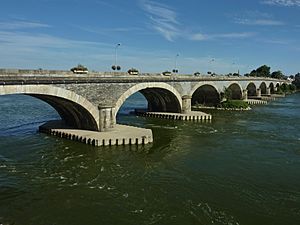Lancaster's Loire campaign of 1356 facts for kids
Quick facts for kids Lancaster's Loire campaign of 1356 |
|||||
|---|---|---|---|---|---|
| Part of the Hundred Years' War | |||||
|
|||||
| Belligerents | |||||
| Commanders and leaders | |||||
Imagine a time when knights and armies battled across France! In August 1356, during the Hundred Years' War, an English army set out from Brittany. It was led by a brave commander named Henry, Duke of Lancaster. His big goal was to meet up with another English army. This second army was led by Edward, the Black Prince, near a city called Tours. But the French army had a clever plan. They destroyed bridges over the Loire River. This made it impossible for Lancaster to cross. So, he had to turn back, returning to Brittany in September.
Contents
Lancaster's March Through France
What Was a Chevauchée?
In August 1356, Henry, Duke of Lancaster, began his march. He led his army south from eastern Brittany. This journey was a special kind of military raid. It was called a chevauchée (say: sheh-voh-SHAY). A chevauchée was a large-scale raid by mounted soldiers. Its main goal was to cause damage and fear. It also aimed to gather supplies and weaken the enemy.
Joining Forces with the Black Prince
Lancaster's main mission was to join another English army. This army was led by Edward, the Black Prince. The Black Prince was the oldest son of the English king, Edward III. His army had started its march north on August 8. They began from a town called Bergerac. The plan was for both armies to meet near Tours.
Lancaster had about 2,500 soldiers with him from Normandy. He also commanded over 2,000 soldiers. These soldiers were guarding English forts in Brittany. It's not fully known how many of these fort guards joined his marching army.
The Uncrossable River Loire
The Loire River was very full that year. This was unusual for the season. The French army had also destroyed or strongly guarded all the bridges. This made it very hard for Lancaster to cross. He could not meet up with the Black Prince.
In early September, Lancaster gave up trying to cross. He tried at a place called Les Ponts-de-Cé. But it was too difficult. So, he decided to turn back. He led his army back to Brittany.
Capturing French Strongholds
On his way back, Lancaster's army didn't just retreat. They captured many French strongholds. These were like small forts or castles. His army then left their own soldiers to guard these new places. Once he reached Brittany, Lancaster began a siege. He laid siege to Rennes, which was the capital city of Brittany.
The Battle of Poitiers
The Black Prince also started to head back. He had waited near Tours for Lancaster. This delay gave the French army time to catch up. The French army was led by their king, John II.
Because the French army caught up, the Black Prince had to fight. This led to the famous Battle of Poitiers. In this battle, the French army suffered a huge defeat.


